Rome is a massive city, and home to five of the medical schools in Italy that offer medicine in English. Three of these are Private Medical Schools: UniCamillus, Biomedico, and Cattolica, and two of them are public medical schools: La Sapienza and Tor Vergata. Of course depending on the university of your choice popular neighbourhoods among those students might change, however in general we can organise student accommodation in different neighbourhoods under similar parameters. Some areas are nicer than others, whereas some areas have much better amenities and connections.
Finding a place that will suit you depends on a lot of factors such as pricing, privacy, amenities, connections, willingness to commute, noise levels etc. So in this article we’re going to go over some of the different parameters to help you understand where to start look for housing in Rome. Of course there are so so many different neighbourhoods and areas that might still be well connected and affordable that we won’t cover, but I will go over the most popular ones for students.
Considerations for Student Housing
Transportation
Transportation (other than price) is the most important consideration when choosing your area. As not only how well the area is connected to the university matters, but also how well it’s connected to social areas and other places that might be of interest to you. If you can walk to the university, but there’s no night buses you might have to pay €100s in taxi fees if you want an active night life etc. In general transportation is more of a consideration for La Sapienza students, as a majority of Tor Vergata students live on the outskirts of the city so are much more limited in their considerations. However I will go over each of the ways to travel in the city and to the university, so that you can make an informed decision on what you’re willing to sacrifice.
I really recommend reading our guide about transportation in Rome to also get a better idea of how it functions.
Walking
To start off with this is really only an option for Sapienza students as TV students will need to get a bus to get to the medical campus, unless they live on Place CX (Campus X). Walking is a popular option among La Sapienza students, and there are a few areas that will easily support this depending on your budget. You have to be aware though by selecting an area that is closer, you might have to compromise on other things such as amenities, affordability or noise levels.
Starting from the closest areas you will probably have to pick among Policlinico (most expensive), Piazza Bologna (moderately expensive), and San Lorenzo (cheap, but very active/noisy night life). There are slightly further areas that will support walking, but will take around 30 minutes instead for a slowish walker, such as Tiburtina (slightly closer), Casal Bertone, or for a more prime location closer to the city centre the area surrounding termini.
Biking
Biking can be very dangerous in Rome, even though there is increased infrastructure being bulit right now to encourage alternative transportation for commuters. The government started offering programmes to pay for the cost of bikes, and e-scooters, as well as finally building more biking paths around the city and university, so this is an increasingly popular option among students and workers alike, however please do be aware that you will need to be very careful. Rome is one of the busiest cities in Europe, and drivers can be quite reckless and aggressive, so while a lot of students do love to bike in the city, we would seriously caution this consideration.
Biking is a good option for those who want to live somewhere medium distance away, but not be a great choice for long distances especially during the winter where you might be cycling to and from university in the dark.
Trams
Tram is another big possibility for La Sapienza students connecting popular areas like Pigneto which is very affordable and residential, with Piazza Verano which has both the 3 and 19 Tram lines as a stop (as well as the hospital). This means that Sapienza students can also consider any area that these lines run through, as they will be able to get to both their classes and hospital placements with relative ease.
Metro
In general Tor Vergata students can live anywhere along the Orange line of the metro, as there is an Express Bus (No. 20) which is quite reliable and fast to take you from Anagnina metro stop to the Medicine & Surgery Faculty. Of course the blue or green line are also options, but you will need to do a switch at some stage to the orange, or take a different connecting bus.
The Blue Metro line will hold the same for La Sapienza, as the university hospital (Policlinico Umberto Primo) has it’s own stop which serves the hospital and the university, but keep in mind this metro stop has been closed for a few months now for maintenance. Termini which is the main central station in Rome that connects everything including the orange, and blue metro lines is also a walkable distance from the university, so if students would really prefer to live along the orange line it is possible to get off at Termini and walk. Switching to blue line at termini and getting off at policlinico to walk is also an option, but will basically take the same amount of time.
Buses
Our final option is the bus, which I would say is how a majority of the students travel to university. Tor Vergata students have the 20, and 058 that drops them off at the door of the Medicine and Surgery Faculty, whereas La Sapienza students have a huge number of options considering both Tiburtina and Termini which are walkable distances from the university are major hubs for bus lines. Piazza Verano is a 5 minute walk from the entrance of the university and has 2 tram lines (3 & 19) as well as a huge variety of buses serving it such as the 38, 71, 88, 310, 448, 163, 545, 490, 492, etc. which is incredibly convenient for students who choose to live in other areas, but especially Trieste, Tiburtina, and Casal Bertone.
Pricing
Of course everyones budget is going to be different, and there is a massive price difference from area to area, as well as depending on a few different choices, such as whether you want a whole apartment to yourself, just a room to yourself or if you would be willing to share a room for the cheapest price possible. It is also possible to find good deals in an area that might be on average more expensive. The following prices and area match ups are to give you a rough idea and aren’t an exact promise on what to expect, but in general sharing a room is going to be the cheapest option no matter where you are with the price increasing for a private room depending on the size and whether or not it has a private balcony or bathroom.
Students willing to share a room can expect to pay around €200-€300 Euro for a shared room closer to the city centre. A private room in San Lorenzo (For Sapienza) or in Anagnina (For TV) can be around €350.00 Euro. Policlinico which would be the most expensive area close to La Sapienza university will be around at least €600 Euro in a shared house.
In general when considering the AVERAGE costs of housing this is the list of least expensive to most expensive areas:
- San Lorenzo
- Pigneto
- Casal Bertone
- Tiburtina
- Trieste
- Bologna
- Around Termini
- Policlinico
Amenities and Facilities
Some areas will have way better services and facilities being more residential, and others will have way more active social scenes so this is an important consideration. In this general parameter we mean supermarkets, gyms, post offices, restaurants, but also sanitation services so how well maintained an area is. In general more expensive areas like Policlinico will be very well maintained and have really nice roads, less litter and waste etc, compared to a way more active neighbourhood filled with night life like San Lorenzo. Areas like Piazza Bologna which is popular for students with many stores, actually have quite limited supermarket and gym options in comparison.
Noise Levels/Crowdedness
Given how busy and crowded Rome is this might be the most important consideration for a future student. Certain neighbourhoods are honestly a vibe, with huge social activities, incredibly busy and noisy nights, and can be considered very vibrant areas that do not sleep early. In general San Lorenzo and Pigneto have social districts full of bars, and in contrast other areas such as Policlinico or Casal Bertone are slightly more residential so might be quieter.
Miscellaneous Considerations
Pets
Roman people love their pets, and you will see dogs allowed into everywhere including indoors in restaurants however house owners aren’t as accepting of animals. There are many places that will take you, and if you can find a place where the landlord doesn’t frequent that often that it would be ok to have a small cat or dog.
However in most cases especially in central Rome it will be quite difficult to find a house that will explicitly allow animals.
Parking
Parking is a massive problem in Rome, and most cars aren’t allowed to pass through the city centre. If you are considering bringing a car, while incredibly convenient to get around and travel to other cities, you need to consider that certain areas will be an absolute nightmare to find reliable parking.
Air Conditioning
Rome is incredibly humid and hot during the summer, especially during August it gets overwhelmingly warm. If you are not coming from a climate that gets muggy and scorching summers, it might be worth trying to find a house with air conditioning. Unfortunately this is more of a luxury than a standard, and can be non-existent in a lot of places. If you are unable to find a place with AC, alternatives can be to buy the small units with a pipe out the window (kind of expensive but a worth it investment if you plan on spending the summers here), loading up on fans, or schedule all of your exams to be done before mid July to escape the heat.
Popular Options for La Sapienza Students
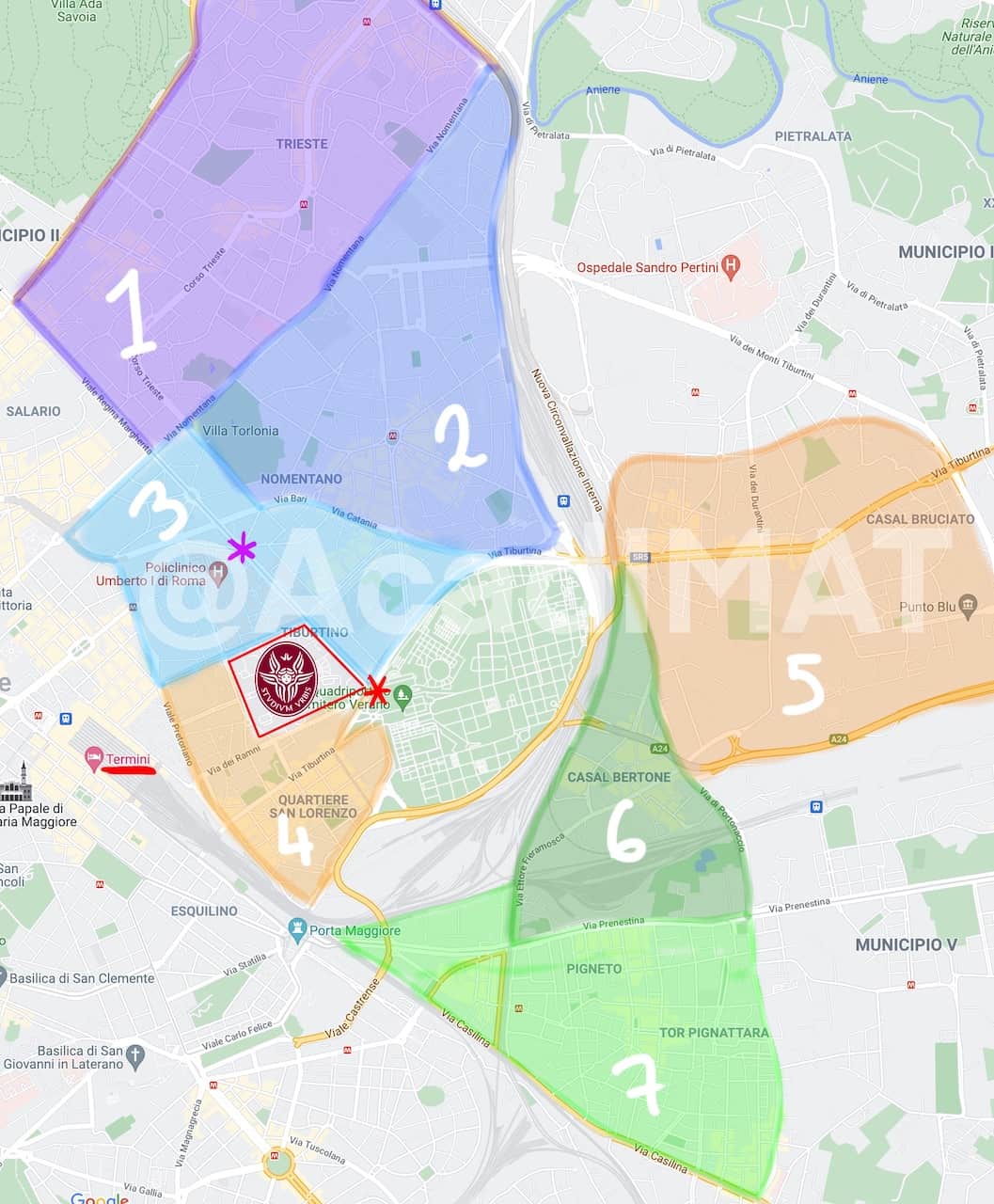
- TRIESTE
- PIAZZA BOLOGNA
- POLICLINICO
- SAN LORENZO
- TIBURTINA
- CASAL BERTONE
- PIGNETO
*RED STAR* = PIAZZA VERANO
*PURPLE STAR* = POLICLINICO METRO STOP
Keep in mind that the above areas are the most popular. La Sapienza students can realistically choose any area that is connected by either metro line (Blue line has policlinico metro stop for the hospital, Orange line has Termini which is a walkable distance to the university). Some students prefer to live further out along the metro lines for cheaper rent and nicer areas, and commute to university on the metro.
Bologna
One of the most popular options and is generally regarded as a student area. It’s on the slightly higher end, but in the middle of the road in terms of both pricing and how well kept the area is. In the centre there is a roundabout with benches all around it that people gather in. In the past this piazza would be filled with 100s of people in the evenings (especially on the weekends) all drinking and socialising, with bars and restaurants surrounding it. There is a metro that is quite convenient as it’s the last stop before the blue line splits into two, meaning that you can take any blue line metro when coming back home instead of waiting for the line that you might need. There are also a few buses, but in general living here means walking to university (always uphill) and taking the metro for anything else.
Policlinico
Probably one of the nicest areas you can live in as a La Sapienza student being so close to the university hospital. The main problem is though that since it is so close to the hospital, it is the residential area for a lot of the doctors and nurses who work there which drives up the price considerably. There are students who live in this area, either alone or with room mates, but they will definitely be paying up to twice the price of the cheaper areas. It is generally quiet, with tidy streets and beautiful small buildings, served by two trams and a metro.
San Lorenzo
The heart and centre of student life in Rome. It is quite vibrant and evenings are packed full of people from all over the city. It is also the cheapest area close to La Sapienza university that you can rent a house in. We really recommend you check out this neighbourhood before you decide to move in just because the pricing seems suitable. The noise levels from the massive crowds combined with what can only be described as party energy can shake your windows well into the early hours of the morning, but this is definitely the scene for young students who want to socialise.
Tiburtina
Arguably one of the best connected areas, but quite crowded. There are multiple buses that can take students to Piazza Verano (163, 448, 545) in less than 10 minutes depending on traffic, or to Tiburtina station which allows them to take twice as many buses. Tiburtina station also has a metro, and many trains that connect you to cities outside of Rome instead of requiring you to first travel to Termini. It has many facilities, stores, shops, and amenities however it is quite a busy area both in terms of people and traffic. In general it is slightly more expensive than San Lorenzo and Casal Bertone, but considerably cheaper than Bologna and Policlinico. It is not a party heavy area, but has a huge road going straight through it meaning that it is always busy with traffic during the day.
Casal Bertone
The area between Tiburtina and Pigneto which makes it a pretty good middle of the road option both in terms of cost, but also convenience. Students in this area can expect slightly lower prices, but at the cost of convenience as they will either need to bike to university, or get 1 bus (545) that they are dependent on. Of course it is possible for them to first get to tiburtina to have access to many more buses that will take them to university, or alternatively walk to the tram to get them to the city centre, however generally speaking they are not as conveniently connected. This is a great option for students who prefer to be close enough to areas, without being overwhelmed by possible socialising and paying a more budget friendly option.
Pigneto
Similar to San Lorenzo, Pigneto has many busy and social nights along its streets filled with bars. Of course a lot of the area is actually quite residential serving a much older population, but there are certain hot spots dedicated to drinking and having a night out with friends. A lot of students that live in this area usually commute to university by bike or by tram, and can expect to pay a slightly higher price compared to San Lorenzo, but will still be getting a much better bargain compared to other neighbourhoods without having to miss out on being close to the action. Recently there has also been an increase in the number of restaurants serving food from central, and south America, making it an international hub for different cuisines.
Wild Card
Living outside of Rome and getting the train to university everyday or driving everyday if you have a car. For those of you who don’t mind a more comfortable commute (compared to the packed buses and metros, switching between them and praying that they show up), the train is actually quite comfortable and dependable. La Sapienza being so close to termini, would make it possible to live outside of Rome and get the train to termini, and then walk to university. This is not a common choice amongst students, but certainly one that allows a lot calmer, and cheaper lifestyle.
All of them ranked
- Cost
- Accessability
- Vibrance/Night Life
Most Expensive to Least Expensive
- Policlinico
- Bologna
- Triste
- Tiburtina
- Casal Bertone
- Pigneto
- San Lorenzo
Closest (Most convenient) to Furthest
- Policlinico
- San Lorenzo
- Tiburtina
- Bologna
- Trieste
- Casal Bertone
- Pigneto
Please note that some of the areas above tie. It’s one tram from pigneto which makes it more convenient compared to walking from Bologna. Bologna might be closer, but the only real option is to walk uphill to get to university which might be inconvenient in a heavy rain, whereas pigneto requires one tram ride, so of course this list is not completely accurate, but in general we ranked it by “Ease of access with transport + Vicinity to uni”
Most Socially Active to Most Residential
- San Lorenzo
- Pigneto
- Bologna
- Tiburtina
- Casal Bertone
- Trieste
- Policlinico
Please note that of course all of these areas will have different bars, and social events however we tried to rank it by “most active by students on a random night out”.
Popular Options for Tor Vergata Students
CX Place
Previously known as Campus X, CX Place is a private dormitory located a few minutes away from Tor Vergata. While it might be a little more expensive compared to trying to find your own house, this campus is honestly mind blowing. Andrea from CX place was kind enough to allow us to walk around campus and take pictures which will be coming soon in an article, but I cannot emphasise enough how nice these dorms are. Here are a few photos just to give you an idea
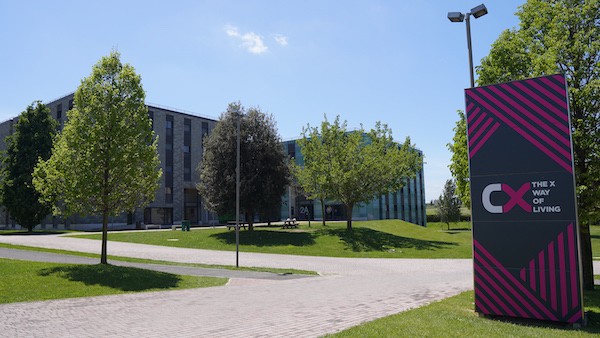
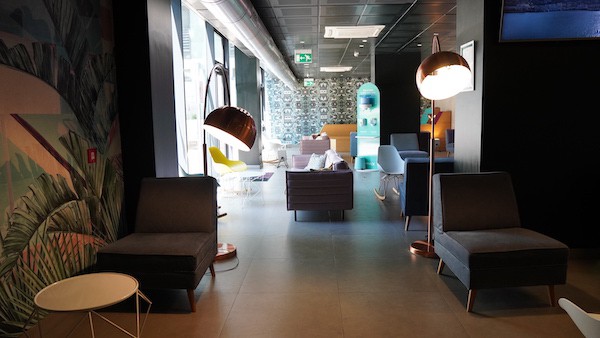
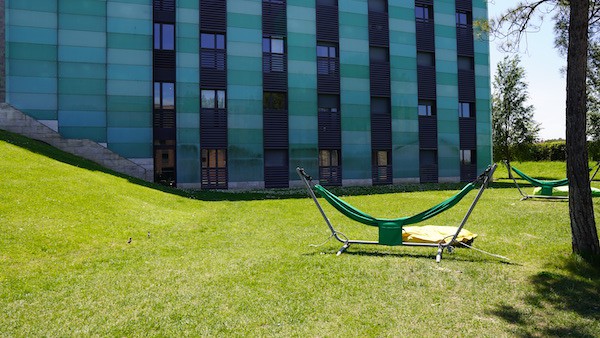
Anagnina
The area around Anagnina is a popular choice for many students as it is conveniently connected by bus to get to and from university with ease. Being a residential area it also has many amenities and comes at a much lower cost on average compared to the centre of Rome, with students being able to find large private rooms with bathrooms for around €350.00 Euro. Anagnina is the last metro stop of the Orange (A) line, so it is also quite convenient for students who would like to travel to the city centre on their time off.
Popular Options for Private Universities
UniCamillus
UniCamillus is a private university located to the East of Rome. There are many neighbourhoods surrounding it, but unfortunately it’s exact location makes it a little bit hard to travel to, and being on the outskirts of the city limits transportation options.
We researched the buses, and the main routes that serve it are the 040, and 041 which both take off from PONTE MAMMOLO (Blue line Metro stop). We have gathered our suggestions below based on the limited research we were able to conduct, and will update this page as we learn more about this university, especially since they will be moving campus in the near future.
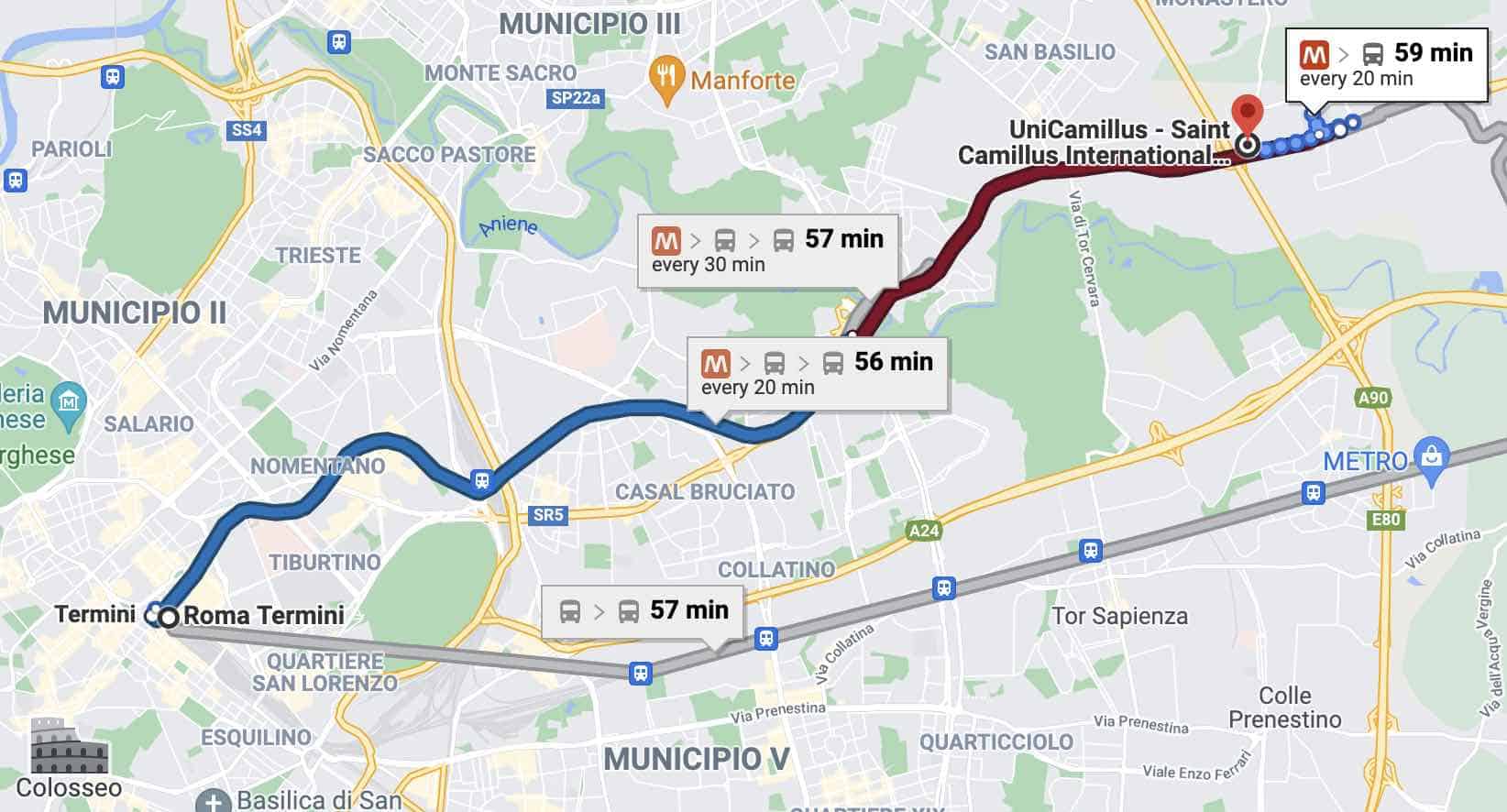
Private Dorms
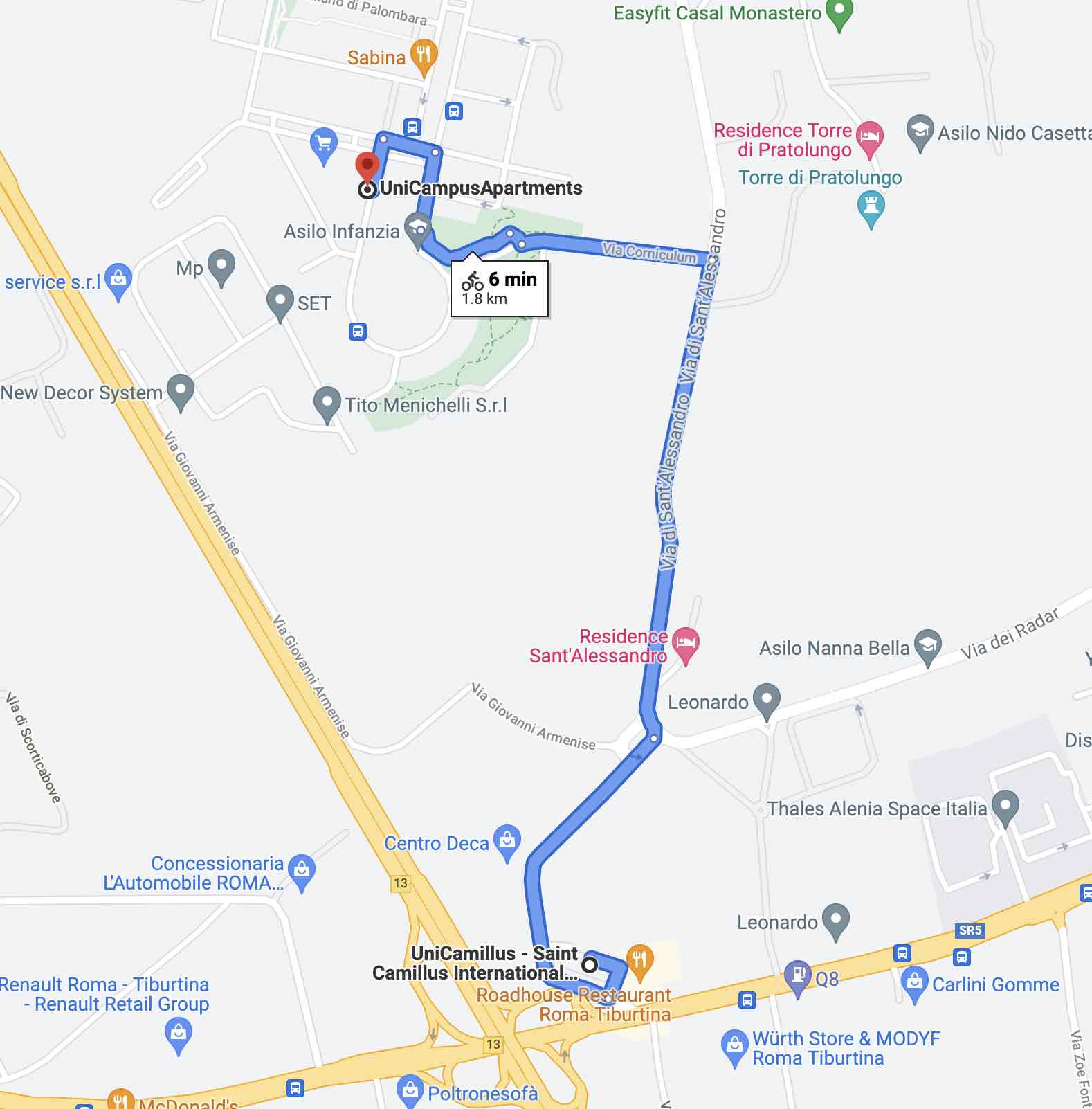
We found one website for private student dorms serving this university called UniCampus Apartments, however their website was quite limited and most of the pages just had coming soon titles. We were however able to gather that they are located in Casal Monastero which is just north of the university campus. According to google maps it is a 5 minute bike ride or a 20 minute walk with no transportation options. To get to the city centre you will need to take a bus to one of the metro stops (Ponte Mammolo or Rebbibia on the blue line) and the metro to the city centre which would take an estimated time of 50 minutes if timings align correctly.
According to their website, the deposit is €1000.00 Euro, and the price per academic year changes based on the room type, however we were unable to fund any information on the differences between the room types.
- Single Room A (twin size mattress): €7500.00 Euro + Taxes
- Single Room B (Queen size mattress): €7900.00 Euro + Taxes
Suggested Areas
The only areas that seemed to be well connected for both getting to the university and to the city centres are Ponte Mammolo and Rebbibia.
Both of these are blue line metro stops (the very ends of the line), and have buses that drop you off at the entrance of the university. Not being too close to the city centre prices will be about average with a private room costing around €400-450 Euro on average. There were closer areas to the university that can also be considered, but this would limit the ease of access to the city centre and would only leave the options of walking or cycling to the campus. Do also keep in mind that the university is building a new campus to house its international students, so might be be in a location way more central in the future.
Cattolica
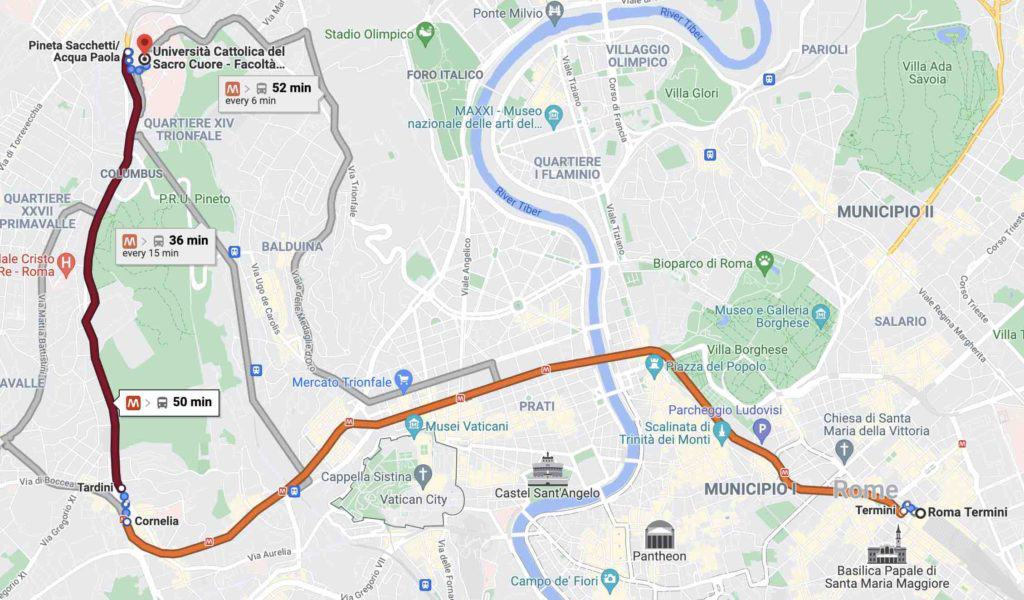
The Rome campus of Cattolica University is located more to the North-West of Rome across the Tevere river. Depending on the amount of commute a student is willing to do they can either live along the bus line, within cycling distance, or along the orange metro if they are then happy to switch and wait for a bus. A lot of students however opt for private dormitories also run by the university, and have a more traditional take on student housing. Gemelli Hospital (Cattolica Universities teaching Hospital) is also reachable by train which can be quite a unique opportunity for students who wish to live outside of the city.
Private Dorms
Many students opt for private dormitories which the university provides for additional cost. They are separated by sex, with women only being allowed into one building, and male students into another.
- The two on campus dorms are: Nuovo Joanneum (for male students only) € 4,200 per year
- San Luca Barelli (for female students only) € 4,400 per year
Here is their website where you can find more information: https://international.unicatt.it/ucscinternational-roma-accommodation
Biomedico (Coming Soon)
How to find Student Housing in Rome
Popular Websites
There are many websites that people can use to find housing in Rome. You can usually set up email alerts with criteria that you specify and it will message you every day with new houses that might match what you are looking for. You need to be very active using these websites as you will need to apply for dozens of rooms before you even get an email back for a viewing. Our best advice is to have a template message ready in Italian along the lines of:
“Hello, I’m an international medical student studying in X university and looking for a long term housing arrangement. This apartment fits a lot of my criteria, and so I would be interested in coming to the viewing. Could you please let me know what day suits you, and in the case that I want to make an offer what documents I need to bring”
We highly recommend mentioning that you are a medical student, as it’s a lot harder to find housing when you cannot prove employment, and not being Italian also makes it significantly more difficult. Search for a few hours a day, sending your message to as many places as possible. Please also be wary that a lot of the ads that are placed are actually done through 3rd party agencies which will require a fee if you sign a contract.
Some Common Websites:
Facebook Groups
This is probably one of the most popular ways to find accommodation. There are dozens of groups that are dedicated to finding apartments to rent, also specifically for students, and also specifically for foreigners. There are huge groups that are named along the lines of “Expats in Rome” etc. One thing to be careful of though is that a lot of these large groups (especially the expat ones) will advertise properties, or have people searching for properties that suit the needs of professional workers with high disposable incomes. For example a lot of people are searching/advertising apartments around the Trastevere area, which is quite expensive and quite useless if you are a student as it’s terribly connected, quite far, and overpriced.
So when browsing through these groups do keep in mind that the high prices and popular locations you see are not reflections of the general housing market in Rome, but more so what internationals working in FAO or the UN are looking for. As a student, it’s good to search in these groups, but definitely don’t be overwhelmed by them!
University Groups
This is our strongest recommendation for finding an apartment. Of course before you get here this is a lot more difficult, but in general once you enroll and join the FB and whatsapp groups of your colleagues there will be a lot of students in the same position as you. In fact a majority of students move in together after the end of the 1st year by renting a bigger house with more rooms, or as students graduate (or leave for Erasmus) upper years will look to replace their friends. Another massive advantage of doing this is, if you have an Italian friend it makes the applying and negotiating process 100 times easier.
It can be a good strategy to rent somewhere temporarily for a few months until you make friends in your class and possibly move in together at the end of the year. Alternatively if you can connect with a few people before you enroll, but you know that are also going to be looking for housing it can be good to start the search together. If you don’t want to commit to moving in with someone before either of you know you’re going to get in, you can also stay in a hostel or airbnb for 6ish weeks and wait until a fellow classmate who also did the same thing.
Agencies
Unfortunately a lot of renting in Rome runs through agencies. So when you apply through facebook groups and websites, you might be surprised to see that it is an agency that is posting the ad and handling the entire situation. In theory this should make the process a lot easier, and you can actually go straight to an agency to help you find an apartment without resorting to desperately searching on websites. The problem is that any house that is rented through a private agency has a fee that the tenant (you) must pay.
The fee is usually 10{bb8d53cabbfbfa48737bbedab9cb9b55bf5183c8f56cc8e5fd88b7a4065b00a7} of the annual rent, so if an apartment is €500 Euro a month, you would need to pay the agency €600 Euro as a fee for helping you sign the contract, even if you did all of the searching, finding, and applying yourself.
It is possible to avoid this, by searching for apartments not advertised by agencies, but you will limit a lot of your choices unfortunately. I believe that in this case Facebook groups give you a greater chance, as it will usually be people who already live in the house (not necessarily the owners) searching for room mates so that the landlord doesn’t have to go through the hassle of finding an agency.
Costs to Consider
Deposits
It is considered the standard to request a minimum of 1 months rent as a deposit. However anything up to 2 months of rent can be normal. This will be in addition to your first month of rent that you will need to pay when you’re signing the contract, before you’re allowed to move in. If you don’t have an unusually awful landlord you can expect to receive your deposit back when moving out, granted there was no damage to the property caused by you. In a lot of cases if the landlord agrees you can use your deposit as your last month of rent instead, so that you don’t pay for the last month and the landlord returns nothing to you.
Agency Fees
As mentioned above in a lot of cases agencies require you to pay 10{bb8d53cabbfbfa48737bbedab9cb9b55bf5183c8f56cc8e5fd88b7a4065b00a7} of the annual rent which works out to be just over 1 month of rent. This is quite annoying as it doesn’t matter how much or little they helped you, but if you found the house through one of the ads they posted it will be you who is required to pay it. So your initial payment can become annoyingly expensive if you consider the fact that when you sign the contract you will need to pay:
- 1st month of rent (minimum)
- Possibly 2 month deposit (which you will ideally get back)
- 10{bb8d53cabbfbfa48737bbedab9cb9b55bf5183c8f56cc8e5fd88b7a4065b00a7} annual rent agency fee
- Totalling to around 4 months of rent in total just to move in.
Utilities
This can vary a lot depending on the agreement you will have with the landlord. They might pay the bills and you’re required to transfer them the amount every month, or you might be expected to put all of the utilities in your name (more common if you will live alone). Bills that you can expect are:
- Electricity (usually not more than 50 euro a month, lower if you live with more people)
- Gas (very cheap, only a couple of euro a month realistically)
- Trash tax (billed annually, landlord might pay it or expect you to do so)
- Condominio (changes in every building and is the price for the upkeep of the apartment such as cleaning of the stairs, elevator maintenance, paying the guard if you have one etc.)
- Internet (a lot of houses will not provide internet and you will need to take out a contract and pay all associated fees to set it up)
Transport
We really recommend you read our article on transportation in Rome, to better understand the costs. However if you live very close to the university and plan to walk/bike everyday, an annual transport ticket might not be something you need to consider. Instead it might be more worth it to buy individual tickets for when you want to travel into the city. If you want to live slightly further away, then you might have to factor in the cost of the annual transport ticket which is €250.00 Euro (especially Tor Vergata students staying in Anagnina).
If you live in an area that is only really accessible by tram and not one of the night buses the prices of taxis to get back home can also easily start racking up so is also important to think about.
Scholarships
There are scholarships and grants for international students studying in Rome that can range from help towards rent to complete dorms provided and paid for. There are many different locations for dorms, so it’s hard to tell where you might get placed, and will generally depend on a ranking that prioritises family income. You can learn more about scholarships for International students from an article we wrote previously, or straight from the LazioDisco website. LazioDisco provides scholarships to all students studying in Rome regardless of university, but individual universities might also offer additional merit based aid.

3 thoughts on “Rome Student Housing: Complete Guide”
I am looking for an agency to rent an apartment near the Universita Cattolica.
how can you housing if you don’t know your imat score?
It’s probably best to wait until you’re sure you have a spot!